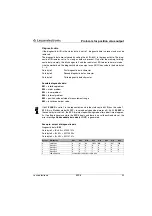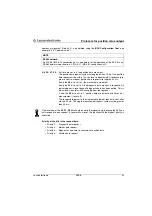
Protocols for position value output
Leuze electronic
BPS 8
104
TNT
35/7-2
4
V
Function identifier
In the request telegram, which function should be executed in the device is signaled to the
BPS in the bits
F0
to
F7
. The function identifier is entered in the response telegram. If the
function identifiers is defined, the BPS executes the desired function and sends the associ-
ated response telegram to the control. The following function identifiers are currently
defined:
90
d
(5A
h
)
:
Request position data
:
Activates positioning mode when this is deactivated. Once a position
value is available, it is sent to the control. Positioning mode remains
active, and is only deactivated after 10 s. If a position value is requested
once again within these 10 s, positioning mode remains active (retrigger).
• Response time with deactivated positioning mode:
≤
4 ms with BUSY response (see diagnostic data)
• Response time with activated positioning mode:
≤
4 ms
• Minimum request interval: 10 ms
• Maximum request interval for retrigger: 10s
91
d
(5B
h
)
:
Request one-time transmission of position data
:
Activates positioning mode; determines and sends position data once.
Positioning mode is subsequently deactivated (laser on – measurement
– laser off).
• Response time with deactivated positioning mode:
≤
40 ms
• Response time with activated positioning mode:
≤
4 ms
• Minimum request interval: 40 ms
92
d
(5C
h
)
:
Activate positioning mode
:
Activates positioning mode; the BUSY response is sent immediately. The
bits
DIA0
to
DIA3
(see diagnostic data) and the bit
OUT
are set to 1 in the
status byte of the response telegram. 0 is sent as a position value.
If a request is sent after approx. 35ms with the function identifier
"Request position data" or "Request one-time transmission of position
data", this request is answered with a response time of
≤
4 ms.




































